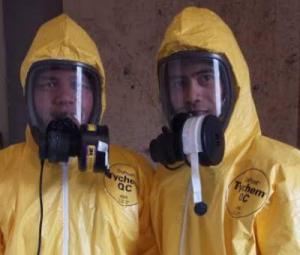Bio-Hazards Decontamination
Infection prevention and control (IPC). Enviro-Vac risk assessors are CSA certified in the scientific approach, practical solutions to, and principals of infection control and protecting others from COVID-19 during decontamination work including use, and application of infection prevention measures. Enviro-Vac decontamination teams undergo a broad-based training regimen in hazardous materials abatement and decontamination and are led by qualified and experienced team leaders.
Our control strategies in place are backed with over 40-years of decontamination experience in an ever changing, wide-ranging industry. We perform thorough risk assessments and exposure control plans, using appropriate combinations of engineering and administrative controls, safe work practices, and personal protective equipment (PPE) to prevent worker exposures.
VIRUSES
Bats are unique and capable of rapidly reproducing highly transmissible viruses. While the bats can tolerate many viruses, when these bat viruses then move into animals or humans that lack a fast-response immune system, the viruses quickly overwhelm their new hosts, often leading to an increased fatality rate.
Histoplasmosis is one such infection caused by breathing in spores of a fungus often found in bird and bat droppings. The infection is most commonly spread when these spores are inhaled after taking to the air, such as during demolition or cleanup projects.
Rodent, bird & bat feces, and other organic matter (feathers, bones, body parts, carcasses, etc.) pose a health threat to human beings who come in contact with them or inhale the airborne particles from them. Every precaution should be taken to ensure that workers and building occupants are protected from the diseases carried or transported by rodents, birds and or bats.
 Guano
Guano
Exposure to rodent, bird and bat droppings and nesting materials under ideal conditions can result in a number of diseases, including histoplasmosis, Newcastle disease, cryptococcosis, pseudotuberculosis and other avian transmitted diseases. Another major condition of concern would be hypersensitivity pneumonitis. This disease is generally contracted by inhaling a specific type of bacteria (thermophilic actinomycetes). The ubiquitous organisms, whose primary purpose is the decomposition or organic matter, have been isolated from manure, bird droppings, grain compost, hay, etc. Thermophilic actinomycetes are generally not a concern in the indoor environment. The presence of nesting birds in any portion of the building HVAC system and the potential introduction of the associated diseases that they cause become a real concern.
Rodent Droppings
Some rodents are infected with a type of hantavirus that causes (HPS). Deer mice (plus cotton rats and rice rats in the Southeastern states and the white-footed mouse in the Northeast) are the rodents carrying hantaviruses that cause hantavirus pulmonary syndrome. These rodents shed the virus in their urine, droppings and saliva. The virus is mainly transmitted to people when they breathe in air contaminated with the virus. This happens when fresh rodent urine, droppings or nesting materials are stirred up.
These possibilities demonstrate why disinfecting rodent-infested areas is so important in preventing transmission of the viruses.




